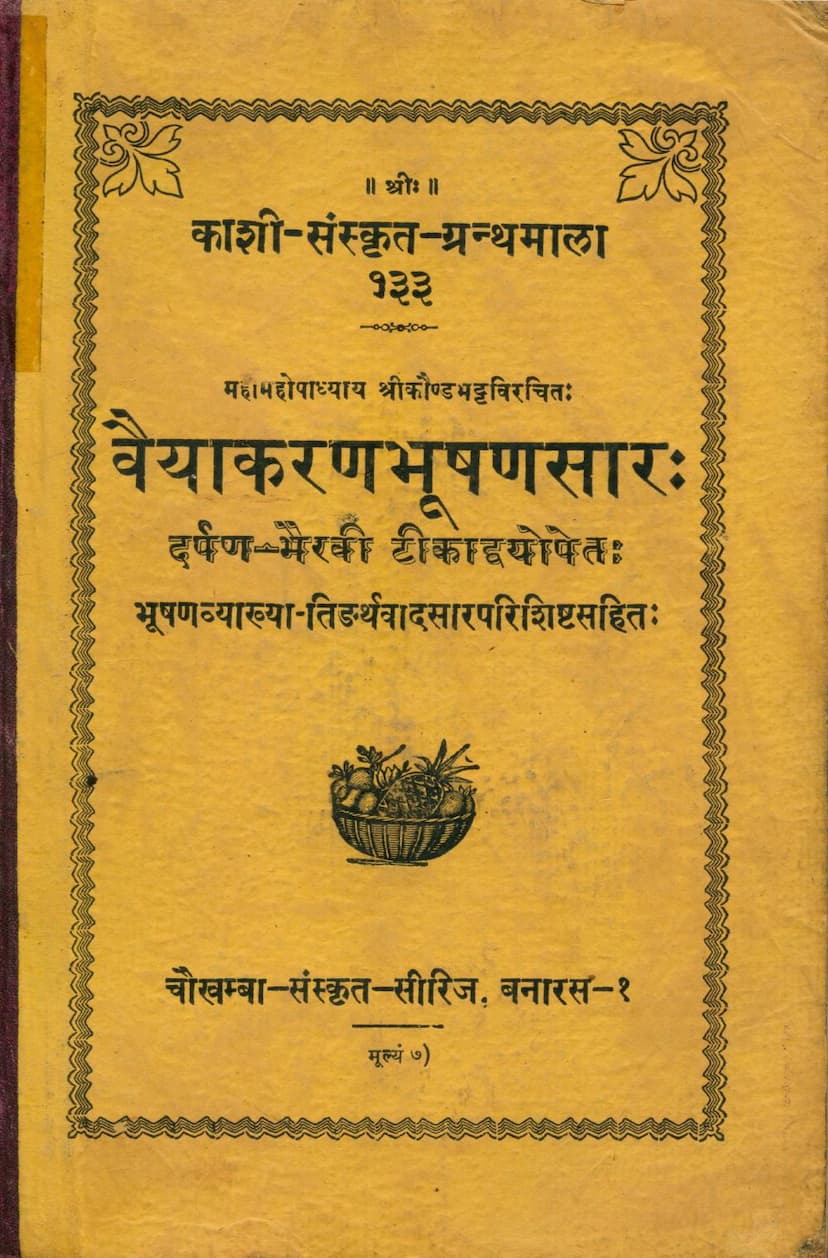Vaiyakaran Bhushansara
Added to library: September 2, 2025

Summary
This comprehensive summary focuses on the key aspects of the Jain text "Vaiyakaran Bhushansara" based on the provided pages, outlining its content, context, and significance.
Book Title: Vaiyakaran Bhushansara Author: Shreekaund Bhatt (Primary Author), Sadashiv Shastri Joshi (Editor) Publisher: Chaukhambha Sanskrit Series Office Catalog Link: https://jainqq.org/explore/023384/1
Overview:
The provided pages introduce and offer a glimpse into the "Vaiyakaran Bhushansara," a significant work on Sanskrit grammar (Vyakarana). The text, authored by the renowned scholar Shreekaund Bhatt and edited by Pt. Sadashiv Shastri Joshi, is part of the Kashi Sanskrit Series. It is a comprehensive treatise that delves into various intricate aspects of grammar, presented with multiple commentaries. The introduction highlights the importance of understanding the Vedas and their six auxiliary limbs (Vedangas), with grammar being a crucial one.
Key Themes and Content:
-
Importance of Vedic Study: The introduction (Bhumika) emphasizes the supreme authority of the Vedas among all means of knowledge (pramanas). It argues that while direct perception (pratyaksha) and inference (anumana) are valid, they are insufficient for understanding spiritual truths and the means to achieve ultimate good (shreyas), which are exclusively revealed by the Vedas.
-
Vedangas: The text details the necessity of studying the six Vedangas (Shiksha, Kalpa, Vyakarana, Nirukta, Chandas, Jyotisha) for a proper understanding of the Vedas. Each Vedanga is explained in terms of its purpose and contribution to Vedic interpretation.
- Shiksha: Focuses on pronunciation, accent, and articulation.
- Kalpa: Deals with rituals and the proper application of Vedic injunctions.
- Vyakarana: The core subject, focusing on the structure, rules, and nuances of Sanskrit grammar.
- Nirukta: Explains the etymology and meaning of Vedic words.
- Chandas: Studies Vedic meters.
- Jyotisha: Covers Vedic astronomy and the determination of auspicious times for rituals.
-
Grammar (Vyakarana) as a Supreme Limb: Vyakarana is presented as the "Veda of the Vedas," essential for comprehending the precise meaning of Vedic texts. Panini's grammar is highlighted as the most authoritative and comprehensive work, forming the foundation of this study.
-
Vaiyakaran Bhushansara: The specific text is introduced as a detailed exploration of grammatical principles. The "Bhumika" mentions that the work elucidates concepts like the meaning of roots (dhatvartha), verbal inflections (lakārartha), noun stems (subartha), and noun meanings (namartha). It stresses the importance of this grammatical knowledge not only for grammarians but also for scholars of logic (Nyaya) and Mimamsa.
-
The Author and Commentaries: Shreekaund Bhatt is identified as the author, and the text is published with several valuable commentaries, including:
- Darpana Commentary: By Sri Harivallabha.
- Pariksha Commentary: By Bhairava Mis'ra.
- Bhushanavyakhya: A short commentary by Sri Kris'na Mitra.
- Tinarthavadasara: By Sri Khuddī Jha Sharma. The editor, Pt. Sadashiv Shastri Joshi, has compiled and presented the text with extensive notes and introductions.
-
Philosophical Underpinnings: The text touches upon philosophical concepts related to language, such as the eternal nature of sound (Shabda-Brahman) and the concept of Sphota, which grammarians consider the ultimate reality of sound.
-
Structure and Content: The "Sanga Suchika" (Table of Contents) indicates the book's structure, covering various aspects of grammar like the meaning of roots, tenses, case endings, compound words, negation, particles, and the concept of Sphota.
Significance:
The "Vaiyakaran Bhushansara," with its detailed commentaries, serves as a valuable resource for advanced students and scholars of Sanskrit grammar. It aims to provide a profound understanding of the language, enabling a deeper grasp of Vedic literature and philosophical texts. The inclusion of multiple commentaries suggests a commitment to thoroughness and catering to different scholarly perspectives. The text's inclusion in the Kashi Sanskrit Series underscores its academic and traditional importance.